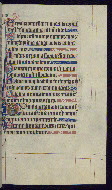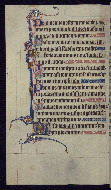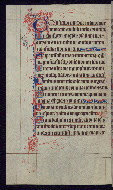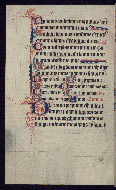Home > Digitized Walters Manuscripts
This document is a tranformation of a TEI P5 XML manuscript description incorporating images. If you have trouble reading special or non-Latin characters on this page, please make sure you have appropriate Unicode fonts installed and an up-to-date web browser.
Walters Ms. W.79, East Anglian Psalter
Browse images (Browse images in a new window) | TEI in XML format
W.79
East Anglian Psalter
This English Psalter was made for an East Anglian patron at the beginning of the fourteenth century. The original Psalter contains a calendar for adapted Sarum use, the Psalms, Canticles, Litany, and Office of the Dead, with additional prayers in a humanist hand added by a fifteenth-century owner. The text is incomplete; about two dozen leaves have been removed, resulting in missing historiated initials and several partial Psalms and Canticles. Three extant historiated initials, accompanied by incipits in gold, stand out among a multitude of smaller painted and flourished initials. The majority of the text is written in an accomplished textualis prescissa. This Psalter has stylistic and textual connections to the Gorleston Psalter (British Library, Add. Ms. 49622) and the Ormesby Psalter (Bodleian Library, Douce Ms. 366), placing it firmly within the tradition of East Anglian manuscript production in the first half of the fourteenth century.
First half of the 14th century CE
East Anglia, England
Book
Devotional
The primary language in this manuscript is Latin.
- Transliteration: Finito libro sit laus et gloria Christo. Amen.
- Translation: The book is finished. Praise and glory be to Christ. Amen.
- Comment: Separated from the end of the Office of the Dead text by seven lines; letters in blue with lines outlined in red, with penwork profile head at text end
Parchment
Parchment of medium thickness; some water damage to tops of folios in calendar
Foliation: iii+194+v
Consistent modern pencil foliation inner upper right corners, rectos (used here); foliation is misnumbered at 177: 177, 177bis, 178..., resulting in 194 folios numbered only to 193; several sets of other numbers; occasional pencil foliation on side margins; occasional inconsistent foliation at upper right corners, rectos; two of the back flyleaves are parchment, all other flyleaves are modern
Formula: iii, 1(6,-5), 2(6), 3(8,-1), 4(8), 5(8,-2,-7), 6(8), 7(8,-2, 3,4,5), 8-12(8), 13(8,-6,7), 14-16(8), 17(8,-3,6), 18-20(8), 21(8,-4,5), 22(2), 23(8,-1,8), 24-27(8), 28-29(2), v
Catchwords: Quires of eight marked with catchwords on versos in lower middle margins of page, horizontally within ruled lines.
Signatures: None
Comments: Quires begin on fols. 1(1), 6(2), 12(3), 19(4), 27(5), 33(6), 41(7), 45(8), 53(9), 61(10), 69(11), 77(12), 85(13), 91(14), 99(15), 107(16), 115(17), 121(18), 129(19), 137(20), 145(21), 151(22), 153(23), 159(24), 167(25), 175(26), 182(27), 190(28), 192(29). The 3 bifolia of quire 2 (beginning on fol. 6) fit inside the bifolium that is now quire 22 (beginning on fol. 151). Quire 29 is a fifteenth-century added bifolium.
22.0 cm wide by 33.8 cm high
13.5 cm wide by 21.5 cm high
- Columns: 1
- Ruled lines: 18
- Text ruled in brown ink, some prickings visible; layout does not apply to calendar (fols. 1r-5v, 32 lines, ruled in red ink) or Prayers to SS Anthony, Adrian, and Sebastian (fols. 192r-193r, 10-36 lines)
- Title: Psalter and Office of the Dead
- Text note: Incomplete; lacks textual material from the Canticles and has several partial Psalms, folios from the Canticles have been moved from their original location and now appear after the Calendar. Original manuscript contained the Calendar, Psalms, Canticles, Litany, Office of the Dead. Musical notation present in the text of the Office of the Dead. Prayers to SS Anthony, Adrian, and Sebastian were added in the fifteenth century.
- Hand note: Textura prescissa, with smaller version used in sections meant to be sung; calendar in textura quadrata
- Decoration note: Three six-line historiated initials with tooled gold grounds, with incipits in gold, at major Psalm divisions; two-line initials in blue filled with foliage or grotesques on gold ground begin regular psalms and canticles; one-line red and blue capitals with contrasting pen flourishes throughout; line endings with decorative patterns, animals, and generic heraldic insignia; small amount of marginalia includes animals and hybrids; text in black ink
- Title: Calendar
- Contents: Incomplete: lacking September/October; Sarum use, with the exception of Winwaloe (March 3); half-full, graded blue, red, and gold
- Decoration note: Text primarily in blue and red ink; pen flourishes of foliage, hybrids, and male heads; water damage
- Title: Psalms
- Incipit: Dominus dixit ad me (Psalm 2:7)
- Contents: Incomplete; begins Psalm 2:7, lacks 20-21:6, 24:21-26:1. 36:2-38:5, &9:15-81:11, 85:14-87:8. 108:24-109:7, 113:9-114:1, 147:17-150
- Decoration note: Three historiated initials at Psalm 52 (fol. 56r), Psalm 68 (fol. 69r), and Psalm 97 (fol. 100r)
- Title: Canticles
- Incipit: ...haurietis aquas in gaudio (Isaiah 12:3), fol. 148
- Text note: Incomplete and misbound, the canticles originally clearly followed the psalms; fols. 6r-11v originally placed between fols. 151 and 152; lacks Magnificat and Nunc dimittis, and parts of Canticle of Isaiah, Benedictus Quicumque vult; Contents: Confitebor tibi (partial, only Isaiah 12:3-6, fol. 148r), Ego dixi in dimidio (Isaiah 38: 10-20, fols. 148r-149r), Exultavit cor meum (I Samuel 2:1-10, fols. 149r-149v), Cantemus domino (Exodus 15: 1-19, fols. 150r-151r), Domine audivi (Habacuc 3:2-19, fols. 151r-151v, 6r-7r), Audite caeli (Deuteronomy 32:1-43, fols. 7r-10v), Te deum (fols. 10v-11v), and Benedicite (Daniel 3:57-88, fols 11v, 152r-152v), Benedictus (partial, only Luke 1: 68-72, fol. 152v), Quicumque vult (partial only fols. 153r-154r)
- Title: Litany
- Incipit: Kyrie eleyson
- Contents: Incomplete; Litany of the Saints lacks the end of the petitions and collects (after fol. 158v); Litany has a slight Cluniac bias, including Pancras and Maiolus as the last two of 31 confessors. Many Norman and Breton saints including Taurinus (7), Audoen (13), Romanus (14), Paternus (15), Machutus (18), Melanius (19), Maurilius (20), Philibert (24) Wandregisil (25), Ansbert (26)
- Title: Office of the Dead
- Rubric: In vigilia mortuorum
- Incipit: Dilexi quoniam exaudiet Dominus
- Contents: Use of Sarum; square musical notation on four red staves for antiphons, responses, and versicles, each beginning with a Lombard capital
- Decoration note: Decorated by a different hand than Calendar, Canticles, Psalms, and Litany; opens with a five-line initial filled with red penwork of grotesques (fol. 159r); two-line initials in red and blue with contrasting pen flourishes; line endings feature a greater variety of animals and fish in addition to geometric patterns; Lombard capitals of antiphons, responses and versicles are each decorated with a male head in profile in brown ink
- Title: Additional Prayers
- Rubric: De Sancto Anthonio
- Incipit: Anthoni sancte pater salutaris
- Contents: Prayers to SS. Anthony, Adrian, and Sebastian added by a fifteenth-century owner
- Hand note: Humanistic script
fol. 33v:
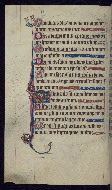
- Title: Initial "A" with hybrid figure wielding sword
- Form: Inhabited initial "A," 2 lines
- Text: Psalm 28
fol. 51v:
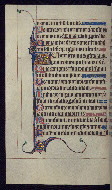
- Title: Initial "A" with hybrid figure wielding sword
- Form: Inhabited initial "A," 2 lines
- Text: Psalm 48
fol. 56r:
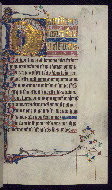
- Title: The fool speaking to God; two hounds chasing a rabbit marginal decoration
- Form: Historiated initial "D," 6 lines
- Text: Psalm 52
- Label: The fool stands in a quartered tunic, holding his loaf and rattle. He looks up toward God in the upper right corner. The fool is often associated with a bicolored tunic, though here he appears in a distinctive quadripartite blue and dull pink tunic. The style of this historiated initial recalls North French and Flemish examples.
fol. 61v:
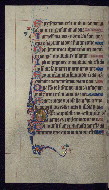
- Title: Initial "D" with male supplicant
- Form: Inhabited initial "D," 2 lines
- Text: Psalm 59
- Label: This initial depicts a male supplicant dressed in a dull-pink hooded robe. This image is related to two other initials in this manuscript that depict similar male supplicants (fols. 96r and 102V).
fol. 69r:
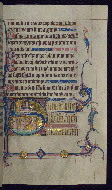
- Title: Three men in water pray to God; archer shooting at a hybrid man marginal decoration
- Form: Historiated initial "S," 6 lines
- Text: Psalm 68
- Label: Three nude male supplicants appear in the lower half of the "S," up to their waists in water. The trio refer to the text of the Psalm: "Save me, O God, for the waters are come in even unto my soul." The presence of three figures is irregular, as this scene normally depicts only one figure, sometimes that of David, in the water.
fol. 86v:
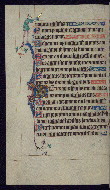
- Title: Man wielding a sword marginal decoration
- Form: Marginal illustration, upper left corner
- Text: Psalm 82
fol. 88v:

- Title: Hybrid man pointing marginal decoration
- Form: Marginal illustration, bottom left corner
- Text: Psalm 84
fol. 89r:
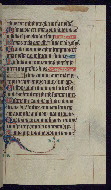
- Title: Hybrid figure wielding a sword marginal decoration
- Form: Marginal illustration, left margin
- Text: Psalm 84
fol. 96r:
fol. 100r:
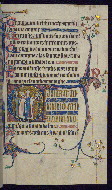
- Title: Three clerics chanting; shepherd trumpeting and fox marginal decoration
- Form: Historiated initial "C," 6 lines
- Text: Psalm 97
- Label: This page depicts an historiated initial containing three tonsured clerics chanting from an open, notated gradual on a lectern before them, all on a tooled gold ground. Each cleric wears a differently colored robe, the first turns the book's pages, the second raises his hand to his chin in contemplation and holds a book in his other hand, and the third holds his hands in prayer. The image of three chanting clerics relates directly to the incipit of the Psalm ("Cantate domino canticum novum..."), which appears in raised gold lettering. The trumpeter in left margin of the page above the words "Et exultaverunt" finds comparison with a shepherd blowing his horn in response to the Annunciation of Christ's birth in the Gorleston Psalter (British Library, Add. Ms. 49622, fol. 126r). The style of this image, like the one at Psalm 52 (fol. 56r), recalls North French and Flemish examples.
fol. 101v:
fol. 102v:
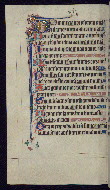
- Title: Initial "D" with male supplicant
- Form: Inhabited initial "D," 2 lines
- Text: Psalm 101
- Label: This page depicts an initial with a male supplicant dressed a dull-pink robe on a gold ground. Psalm 101 was often favored for the depiction of patrons of devotional texts.
fol. 118v:
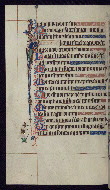
- Title: Hybrid figure marginal decoration
- Form: Marginal illustration, upper left margin
- Text: Psalm 113
fol. 119r:
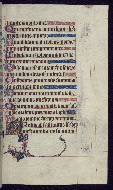
- Title: Hybrid figure marginal decoration
- Form: Marginal illustration, lower left margin
- Text: Psalm 115
fol. 126v:
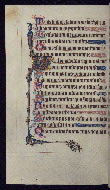
- Title: Hybrid figure marginal decoration
- Form: Marginal illustration, upper left margin
- Text: Psalm 118
fol. 127v:
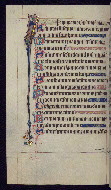
- Title: Hybrid figure marginal decoration
- Form: Marginal illustration, upper left margin
- Text: Psalm 118
fol. 159r:
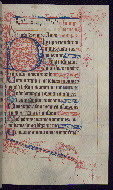
- Title: Initial "D"; hybrid animal marginal decoration
- Form: Inhabited initial "D," 5 lines
- Text: Beginning of the Office of the Dead (Dilexi quoniam exaudiet Dominus)
- Label: This page depicts a large initial "D," inhabited by a multitude of penwork grotesques. Hybrid animals in the same style occupy the lower and right margins. The opening of the Office of the Dead marks a distinct change in style from the rest of the manuscript. More elaborate penwork flourishes enhance both the initials and the marginalia.
fol. 161v:
fol. 163v:
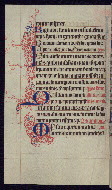
- Title: Initials with elaborate penwork flourishes
- Form: Decorated initial "I," 3 lines; inhabited initials "Q" and "M," 2 lines
fol. 170r:
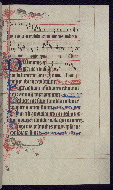
- Title: Inital "D"; hybrid and dog chasing a rabbit marginal decoration
- Form: Inhabited initial "D," 2 lines
fol. 175r:
fol. 190v:
The binding is not original.
Rebound ca. 1900 by Rivière and Son, London; probably unshaped millboard covered in dark blue leather
Made early fourteenth century (possibly for a male patron in Norwich; see Randall 2007, 224) in East Anglia, England
Purchased by Bernard Quaritch, Ltd. at London sale: Sotheby, Wilkinson & Hodge, March 19, 1909, no. 289
Wilfred M. Voynich collection, London, from Quaritch, before 1912
Acquired by Henry Walters, Baltimore, from Voynich on January 19, 1912
Walters Art Museum, 1931, by Henry Walters' bequest
Randall, Lilian M. C. "The Art of Calligraphy." The Walters Art Gallery Bulletin 2 (1983): p. 7.
Folsom, Rose. The Calligraphers' Dictionary. London: Thames and Hudson, 1990, pp. 110, 120 (fol. 163v). .
Burin, Elizabeth. "Medieval Writing and Calligraphy." The Walters Monthly Bulletin 11 (1993): pp. 4-5 (fol. 86v).
Mellinkoff, Ruth. Outcasts: Signs of Otherness in Northern European Art of the Late Middle Ages. Berkeley: University of California Press, 1993, vol. 2, fig. I.21 (fol. 56).
Weiss, Susan Forscher. "Singing Along with Guido and Friends: Music in Manuscripts." The Walters Monthly Bulletin 10 (1996): p. 5 (fol.100).
Randall, Lilian M.C. "Sense and Sensibilities in an Early Fourteenth-Century Psalter from East Anglia." In Tributes to Lucy Freeman Sandler: Studies in Illuminated Manuscripts, edited by Kathryn A. Smith and Carol H. Krinsky. Turnhout: Harvey Miller, 2007, pp. 219-33.
Principal catalogers: Herbert, Lynley; Noel, William; Smith, Kathryn
Cataloger: Walters Art Museum curatorial staff and researchers since 1934
Editors: Herbert, Lynley; Noel, William
Copy editor: Dibble, Charles
Conservators: Owen, Linda; Quandt, Abigail
Contributors: Bockrath, Diane; Dutschke, Consuelo; Emery, Doug; Grollemond, Larisa; Noel, William; Tabritha, Ariel; Toth, Michael B.
The Walters Art Museum
Licensed for use under Creative Commons Attribution-NonCommercial-ShareAlike 3.0 Unported Access Rights, http://creativecommons.org/licenses/by-nc-sa/3.0/legalcode. It is requested that copies of any published articles based on the information in this data set be sent to the curator of manuscripts, The Walters Art Museum, 600 North Charles Street, Baltimore MD 21201.
